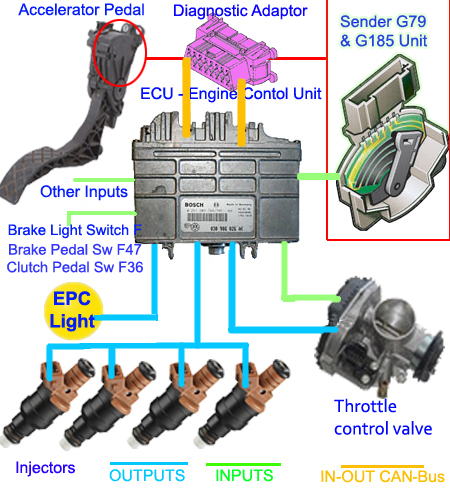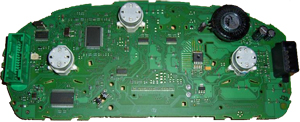Continued from EPC DEMYSTIFIED CONTINUED 1.
... I only became aware of this when my EPC light went on due to the knock sensor. See picture blog. More...
PART 3
BREAKING THE CODE
This influenced the Society of Automotive Engineers (SAE) who subsequently drafted a list of standards and practices that aught to be implemented by all automobile manufacturers and recommended them to the Environmental Protection Agency (EPA). The EPA weighed-up these standards and recommendations, acknowledged their benefits, and adopted them. The standards criteria included a precisely defined diagnostic connector for each auto manufacturer, a standard scan tool and a common electrical communications protocol and a common data format, and the ability to monitor other
vehicle parameters. Lastly that the standard scan tool should interface with vehicles of all manufacturer. It also included mandatory definitions and descriptions for certain emission control system defects which was labeled the ‘P0’ Codes. Manufacturers were allowed to generate and use their own ‘manufacturer specific code descriptions’ known as ‘P1’ Codes. This collaboration of standards became known as OBDII, (OBD2) and was adopted for implementation by January of 1996. Two types of scanner codes, namely manufacturers codes like VAG codes and SEA Codes are now the standard practice.
OBD-II
As mentioned above, Powertrain Control Module (PCM) error codes are assigned the prefix P and pertain to the, Engine management, Transmission management, Fuel Pump and Gasoline Management, Automatic Transmission – Hydraulic Control, Emission control system, evaporative emission purge control (HVAC), Auxiliary module management and other some 0n-board Hybrid application. For example P1340 suggests that the Powertrain triggered a DTC and describes it as an "Crankshaft-/Camshaft Position Sensor Signals Out of Sequence"From the above example it would thus be easy to interpret the DTC below relating to EPC (Electronic Power Control)
DTC (VAG) DTC (SAE) Society of Automotive Engineers
16504 P0120 Throttle Position Sensor A - Circuit Malfunction
16505 P0121 Throttle Position Sensor A - Circuit - Performance Problem - Out of Range
16506 P0122 Throttle Position Sensor A Circuit - Low Voltage Input
16507 P0123 Throttle Position Sensor A Circuit - High Voltage Input
16894 P0510 Throttle Position Sensor - Closed Switch- idle micro-switches -F60 malfunctioning
17951 P1543 Throttle Actuation Potentiometer - Signal too Low
17952 P1544 Throttle Actuation Potentiometer - Signal too High
17913 P1505 Throttle idle micro-switches -F60 not/short-circuit opens
17914 P1506 Throttle idle micro-switches - Switch Does Not Open/Short to Ground
17988 P1580 Throttle Actuator (B1) Fault - May be caused by low battery if found with 16487 (P0103)
18038 P1630 Accelerator Pedal Position -G79 signal too small (low)
18039 P1631 Accelerator Pedal Position -G79 signal too largely (high)
18040 P1632 Accelerator Pedal Position -G79 supply voltage malfunction
18041 P1633 Accelerator Pedal Position -G185 signal too small
18042 P1634 Accelerator Pedal Position -G185 signal too largely
18047 P1639 Accelerator Pedal Position 1+2 Range/Performance -G79 and -G185 implausible signal
18048 P1640 Internal Controller Module defective (EEPROM) Error
EPC Circuit.
The EPC circuit consists of a number of disparate components that control and supervise, regulate and determine the throttle valve position at all times. They include;1) the accelerator pedal position sender (TP sensor G69)
2) the accelerator pedal position sender -2, (G185)
3) Black 6-pin plug with 6-pin with Gold plated contacts
NB! The above three components are part of the accelerator pedal.
4) the throttle valve control module (unit),
5) the K132 EPC fault lamp, (electronic throttle control fault indicator)
6) the engine control module (unit).
Firstly we going to do a test on components 1, 2 and 3 above. To do this test, you need a Fluke multimeter or similar for a voltage and continuity / resistance test. Unplug the 6-pin plug from the accelerator pedal and switch on the ignition. Connect the multimeter and check for a 4.5 volt reading between;-
pin 1 and ground, then between pin 1 and pin 5
Pin 2 and ground, then between pin 2 and 3.
If tests prove to be "OK", switch ignition off.
Do additional checks for short circuits between one another and ground and if this checks "OK",
Locate the ECU, normally inside cowl. Disconnect the ECU from its socket, identify pins 34 & 34, 35 & 36, and 72 & 73 on the socket. Disconnect the 6-pin plug from the accelerator pedal once again and check for continuity between this plug and the ECU socket. There should be continuity between pins:-
1 of the 6-pin plug and pin 72 of the ECU socket.
2 of the 6-pin plug and pin 73 of the ECU socket.
3 of the 6-pin plug and pin 36 of the ECU socket.
4 of the 6-pin plug and pin 35 of the ECU socket.
5 of the 6-pin plug and pin 33 of the ECU socket.
6 of the 6-pin plug and pin 34 of the ECU socket.
Any resistance above 1.5ohms should be investigated for corrosion. This often causes the engine to surge (idle unevenly or rather breaths) However, if this test proves "OK" and no wiring malfunction is detected, replace G69 and G185 (single unit) on the accelerator pedal. NB! these components are non adjustable and needs to be replaced as a whole.
When the ignition is turned on, the ECU checks all EPC components necessary for the proper functioning of the Electronic Power Control. If a malfunction is detected in the EPC (Electronic Power Control) system whilst the engine is running, the ECM will simultaneously activate the EPC (Electronic Power Control) warning light and make an entry of this malfunction in the ECU (electronic Control unit) DTC (Diagnostic Trouble Codes non-volatile memory. By a process of eliminate the EPC fault can be fixed.
The list below categorises VW and Audi manufacturer predetermined data groups which varies depending on the vehicle, year, engine, engine code and management system on board.
Group Number / Group Category
1–9 General engine activity data
10–19 Ignition data
20–29 Knock control data
30–39 02 sensor control system data
40–49 Three-way CAT data
50–59 Engine speed control data
60–69 Throttle drive data
70–79 Emissions reduction data
80–89 Special function data
90–97 Power increase data
98–100 Compatibility data
101–109 Fuel Ignition data
110–119 Boost pressure control data
120–129 Control unit communication data
130–150 Special info data
Based on the data from the above table EPC problems are associated with group 60-69. However, on Expert Systems Diagnostics Group 60, holds the EPC Adaptation data, group 61 holds EPC-system 1 data and group 62 holds the EPC system 2 data. Group 66 holds the speed-o-cruise data.
NB! If you found this information useful, please link to this page.


